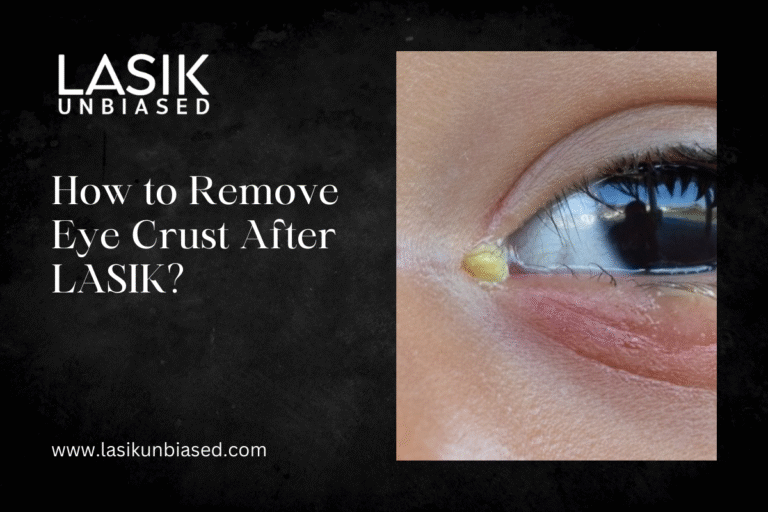To safely remove eye crust after LASIK, use a sterile cotton pad or gauze soaked in warm water, gently wiping the affected area without touching the eye directly.
Avoid using soaps, harsh cleansers, or rough materials that may irritate the skin or eyes.
Post-operative care following LASIK is critical for ensuring proper healing and optimal vision. Eye crust, often a result of the body’s natural healing process or excess lubrication drops, can be bothersome, but it’s important to handle it correctly to avoid complications. This blog provides a step-by-step guide to removing eye crust safely, offering useful tips to keep your recovery on track.
Why Does Eye Crust Form After LASIK?
Eye crust, or discharge, can appear after LASIK surgery due to the healing process. It’s generally a mixture of tear film, lubrication drops, and protein residue. Here are some reasons why this is common:
- Post-Surgery Lubrication: LASIK often temporarily reduces natural tear production, which leads to dry eyes. Artificial tears prescribed after the procedure can mix with natural oils and lead to crust formation around the eyelashes and eyelids.
- Healing Response: Post-surgery, the cornea heals by producing natural secretions, which can dry and accumulate near the eye.
- Foreign Particles: Tiny particles like dust can stick to moisture near the eyes and dry out, forming crusts.
While harmless in most cases, improper removal can cause irritation or introduce bacteria, risking infection. That’s why it’s crucial to follow proper care techniques.
Preparation Before Removing Eye Crust
1. Wash Your Hands
Before touching any area near your eyes, thoroughly wash your hands with soap and water. This reduces the risk of bacterial contamination or infection. Dry your hands with a clean towel.
2. Use Clean Supplies
Always use sterile items like medical gauze or cotton pads to clean your eyelids. Avoid household fabrics like flannels, handkerchiefs, or tissues that may harbour germs or microscopic debris.
3. Warm Compress
A warm compress is incredibly effective for loosening crusts, making it easier and safer to remove. To create a compress:
- Heat clean water until warm (not hot).
- Dip a sterile cloth or gauze into the water and wring it out.
- Close your eyes and place the compress gently over the affected area for 5–10 minutes.
This softens dried crusts, allowing for easy removal without pulling on delicate skin.
Step-by-Step Guide to Safely Remove Eye Crust After LASIK
1. Wet a Sterile Pad or Gauze
Immerse a clean cotton pad or gauze in lukewarm water. Ensure the pad is damp but not dripping to prevent water from entering your eye.
Note: Sterile saline or boiled and then cooled water may be even safer, particularly in regions with less reliable water quality.
2. Gently Wipe Away the Crust
- Close your eye and use the wet pad to gently wipe the crust away in a downward or outward motion.
- Avoid pressing too hard or rubbing, as this may irritate the sensitive area or disrupt healing.
Tip: Always move the pad in one direction and use a fresh pad for the other eye if you’re cleaning both. This avoids transferring bacteria or residue.
3. Avoid the Eye Surface
Ensure that you clean only the skin around the eye. Do not attempt to touch the cornea or inner eyelid. The surgical area is still delicate post-LASIK and should remain untouched.
4. Dispose of Used Pads Properly
Once you’ve removed the crust, discard the used pad or gauze immediately. Avoid reusing materials to minimise bacterial exposure.
Things to Avoid During Eye Crust Removal
To ensure safe care after LASIK, it’s essential to avoid these practices:
- Rubbing or Scratching: Forcefully rubbing the crust or surrounding areas can irritate the eye, loosen the corneal flap, or damage delicate tissues. The critical risk period is typically within the first 7 days.
- Using Sharp Objects: Never use items like tweezers, fingernails, or makeup applicators to remove crust. These increase the risk of injury or infection.
- Harsh Chemicals: Avoid using soap, alcohol, or harsh cleansers near the eyes, as these may irritate or harm the skin and tear film.
- Old Makeup Pads or Tools: Old fabrics, sponges, or tools can harbour bacteria, leading to complications.
- Ignoring Crust Build-Up: Persistent build-up or discomfort may indicate an issue. Always consult your LASIK specialist if in doubt.
When Should You Be Concerned About Eye Crust?
While mild crusting is normal, certain symptoms may indicate an underlying problem requiring medical attention:
- Redness or Swelling: If accompanied by persistent redness, puffiness, or warmth, it could be an early sign of an infection.
- Yellow or Green Discharge: Normal crust is usually clear or white. Coloured discharge may signal an infection.
- Burning or Pain: Discomfort or stinging that doesn’t improve with prescribed drops could suggest an issue.
- Blurry Vision: Any significant changes in vision should be reported immediately to your doctor.
If any of these symptoms occur, consult your LASIK surgeon or eye specialist as soon as possible. Prompt intervention can prevent complications.
Preventing Eye Crust After LASIK
Proactively reducing factors that lead to crust formation can improve your recovery experience. Here’s how to minimise it:
1. Use Prescribed Eye Drops
Follow your doctor’s instructions for lubricating and antibiotic drops. These not only soothe dry eyes but also prevent infections.
2. Avoid Environmental Irritants
Limit exposure to smoke, strong winds, and dusty environments while healing. Wearing sunglasses in outdoor settings is a great way to protect your eyes.
3. Sleep on Your Back
Sleeping face-up helps prevent nighttime irritation and reduces the chances of involuntary contact with your eyes.
4. Avoid Makeup During Recovery
Refrain from using eye makeup, as even trace residues can stick to your eyes and worsen crust formation.
Frequently Asked Questions About LASIK Eye Crust
1. Can I use baby wipes to remove eye crust?
Baby wipes are not sterile and often contain chemicals that can irritate the eyes. Stick to sterile pads or gauze instead.
2. How long does eye crust last after surgery?
Eye crust is typically more prominent during the first week post-surgery and subsides as the healing process progresses.
3. Is crust removal painful?
If done gently and correctly, removing the crust should not be painful. Use a warm compress to soften the crust before attempting removal.
4. Can eye crust come back after it’s removed?
Yes, the crust may reappear until your eyes fully adjust to the procedure. Continue following aftercare guidelines to manage it safely.
5. What if I accidentally rubbed my eye while removing crust?
If you accidentally rub your eye, avoid panicking. Monitor for irritation or discomfort and report any concerning signs to your doctor.
Take Care of Your Eyes Post-LASIK
Proper eye care is critical for a smooth recovery after LASIK, and safely handling eye crust is an essential part of this process. Focus on gentle, hygienic methods like using warm compresses and sterile pads to keep your eyes clean and comfortable.
If you’re unsure about any aspect of your recovery, reach out to your healthcare provider for personalised guidance. Protecting your eyes post-surgery ensures you can fully enjoy your newly enhanced vision.


